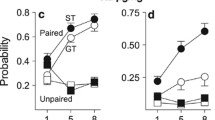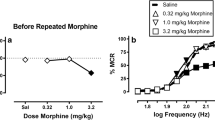Summary
The involvement of opioid systems in self-stimulation reward was investigated by studying the effects of the opioid antagonist naloxone (10 mg/kg s.c.) and graded doses of morphine (0.3–5.0 mg/kg s.c.) on intracranial electrical self-stimulation (ICSS) in rats with electrodes in the ventral tegmental area. Lever pressing for ICSS was analyzed using three different procedures: (1) determination of response rate i.e. the number of responses to high and threshold currents, (2) measuring threshold current when response rate was kept low and relatively constant, (3) determination of ‘behavioural’ threshold using a two-lever procedure in which a response on one lever resulted in a reset of the decreasing current to a high current contingent on a response to the other lever. It was found that low doses of morphine increased the response rate of ICSS behaviour and decreased the threshold whereas the higher doses decreased the response rate but also decreased the threshold current when measured with a rate insensitive procedure. Naloxone raised the threshold for ICSS and caused a corresponding decrease of response rate.
In a second series of experiments in which the behaviour of rats which had been tested in one procedure was analysed using one of the other methods, it was observed that naloxone caused smaller changes, while the effects of morphine were at least comparable to those observed in the first series of experiments.
The present data suggest that response rate insensitive procedures to analyse ICSS should be preferred to response rate sensitive ones, especially when the interaction of depressant drugs such as morphine with reward mechanisms is investigated. It is concluded that opioid systems are involved in ICSS elicited by electrical stimulation in the ventral tegmental area, and that the synergistic action of electrical stimulation and the pharmacological activation of ICSS reward circuits due to morphine may be related to the addictive properties of this drug.
Similar content being viewed by others
References
Belluzi JD, Stein L (1977) Enkephalin may mediate drive-reduction reward. Nature 266:556–558
Bozarth AB, Wise RA (1981a) Heroin reward is dependent on a dopaminergic substrate. Life Sci 29:1881–1886
Bozarth AB, Wise RA (1981b) Intracranial self-administration of morphine into the ventral tegmental area of rats. Life Sci 28:551–555
De Witte P (1981) Effects of naloxone on the self-stimulation behavior of the postero-lateral area of the hypothalamus in rats — influence of procedural conditions. Psychopharmacology 73:391–393
Esposito R, Kornetsky C (1977) Morphine lowering of self-stimulation thresholds: lack of tolerance with long term administration. Science 195:189–191
Esposito RU, Kornetsky C (1978) Opioids and rewarding brain stimulation. Neurosci Biobehav Rev 2:115–122
Esposito RU, Perry W, Kornetsky C (1980) Effects of d-amphetamine and naloxone on brain stimulation reward. Psychopharmacology 69:187–191
Gallistel CR, Shizgal P, Yeomans JS (1981) A portrait of the substrate for self-stimulation. Psychological Review 88:228–273
German DC, Bowden DM (1974) Catecholamine systems as the neuronal substrate for intracranial self-stimulation: a hypothesis. Brain Research 73:381–419
Glick SD, Weaver LM, Meibach RC (1982) Asymmetrical effects of morphine and naloxone on reward mechanisms. Psychopharmacology 78:219–224
Johnson RP, Sar M, Stumpf WE (1980) A topographic localisation of enkephalin on the dopamine neurons of the rat substantia nigra and ventral tegmental area demonstrated by combined histofluorescenceimmunocytochemistry. Brain Research 194:566–571
Kalant H, Engel JA, Goldberg L, Griffiths RR, Jaffe JH, Krasnegor NA, Mello NK, Mendelson JH, Thompson T, Van Ree JM (1978) Behavioral aspects of addiction. In: Fishman J (ed) The bases of addiction. Dahlem-Konferenzen, Berlin, pp 463–496
Kornetsky C, Bain G (1983) Effects of opiates on rewarding brain stimulation. In: Smith JE, Lane JD (eds) The neurobiology of opiate reward processes. Elsevier, Amsterdam, pp 237–256
Lindvall O, Björklund A (1978) Anatomy of the dopaminergic neuron systems in the rat brain. Advances in Biochemical Psychopharmacology 19:1–24
Lorens SA, Mitchell CL (1973) Influence of morphine on lateral hypothalamic self-stimulation in the rat. Psychopharmacologia (Berl) 32:271–277
Mucha RF, Van Der Kooi D, O'Shaughnessy M, Bucenieks P (1982) Drug reinforcement studied by the use of place conditioning in rat. Brain Research 243:91–105
Nazarro JM, Seeger TF, Gardner EL (1980) Morphine differentially affects ventral tegmental and substantia nigra brain reward thresholds. Pharmac Biochem Behav 14:325–331
Olds ME (1982) Reinforcing effects of morphine in the nucleus accumbens. Brain Research 237:429–440
Pellegrino LJ, Pellegrino AS, Cushman AJ (1979) A stereotaxic atlas of the rat brain. Plenum Press, New York
Perry W, Esposito RU, Kornetsky C (1981) Effects of chronic naloxone treatment on brain stimulation reward. Pharmac Biochem Behav 14:247–249
Pollard H, Llorens C, Bonnet JJ, Costentin J, Schwartz JC (1977) Opiate receptors on mesolimbic dopaminergic neurons. Neurosci Lett 7:295–299
Schaefer GJ, Holzman SG (1977) Dose- and time-dependent effects of narcotic analgesics on intracranial self-stimulation in the rat. Psychopharmacology 53:227–234
Schaefer GJ, Michael RP (1981) Threshold differences for naloxone and naltrexone in the hypothalamus and midbrain using fixed ratio brain self-stimulation in rats. Psychopharmacology 74:17–22
Stapleton JM, Merriman VJ, Coogle CL, Gelbard SD, Reid LD (1979) Naloxone reduces pressing for intracranial stimulation of sites in the periaqueductal grey area, accumbens nucleus, substantia nigra and lateral hypothalamus. Physiological Psychology. 7:427–436
Stein L, Ray OS (1960) Brain stimulation reward ‘tresholds’ selfdetermined in rats. Psychopharmacologia (Berl) 1:751–756
Stilwell DJ, Levitt RA, Horn CA, Irvin MD, Gross K, Parsons DS, Scott RH, Bradley EL (1980) Naloxone and shuttlebox selfstimulation in the rat. Pharmac Biochem Behav 13:739–742
Van Heuven-Nolsen D, Van Wolfswinkel L, Van Ree JM, Versteeg DHG (1983) Electrical stimulation of the ventral tegmental area and catecholamine metabolism in discrete regions of the rat brain. Brain Research 268:362–366
Van Ree JM (1979) Reinforcing stimulus properties of drugs. Neuropharmacology 18:963–969
Van Ree JM, Smyth DG, Colpaert FC (1979) Dependence creating properties of lipotropin C-fragment (β-endorphin): evidence for its internal control of behavior. Life Sci 24:495–502
Van Ree JM, De Wied D (1980) Involvement of neurohypophyseal peptides in drug-mediated adaptive responses. Pharmac Biochem Behav 13 (suppl. 1):257–263
Van Wolfswinkel L, Van Ree JM (1985) Differential effect of naloxone on food and self-stimulation rewarded acquisition of a behavioral response pattern. Pharmac Biochem Behav (in press)
Watson SJ, Khachaturian H, Akil H, Coy DH, Goldstein A (1982) Comparison of the distribution of dynorphin systems and enkephalin systems in brain. Science 218:1134–1136
Wise RA (1980) Action of drugs of abuse on brain reward systems. Pharmac Biochem Behav 13 (suppl. 1):213–223
Wise RA (1983) Brain neuronal systems mediating reward processes. In: Smith JE, Lane JD (eds) The neurobiology of opiate reward processes. Elsevier, Amsterdam, pp 405–437
Wood PL (1982) Multiple opiate receptors: support for unique mu, delta and kappa sites. Neuropharmacology 21:487–497
Zarevics P, Setler PE (1979) Simultaneous rate-independent and rate-dependent assessment of intracranial self-stimulation: evidence for the direct involvement of dopamine in brain reinforcement mechanisms. Brain Research 169:499–512
Author information
Authors and Affiliations
Rights and permissions
About this article
Cite this article
van Wolfswinkel, L., van Ree, J.M. Effects of morphine and naloxone on thresholds of ventral tegmental electrical self-stimulation. Naunyn-Schmiedeberg's Arch. Pharmacol. 330, 84–92 (1985). https://doi.org/10.1007/BF00499899
Received:
Accepted:
Issue Date:
DOI: https://doi.org/10.1007/BF00499899




